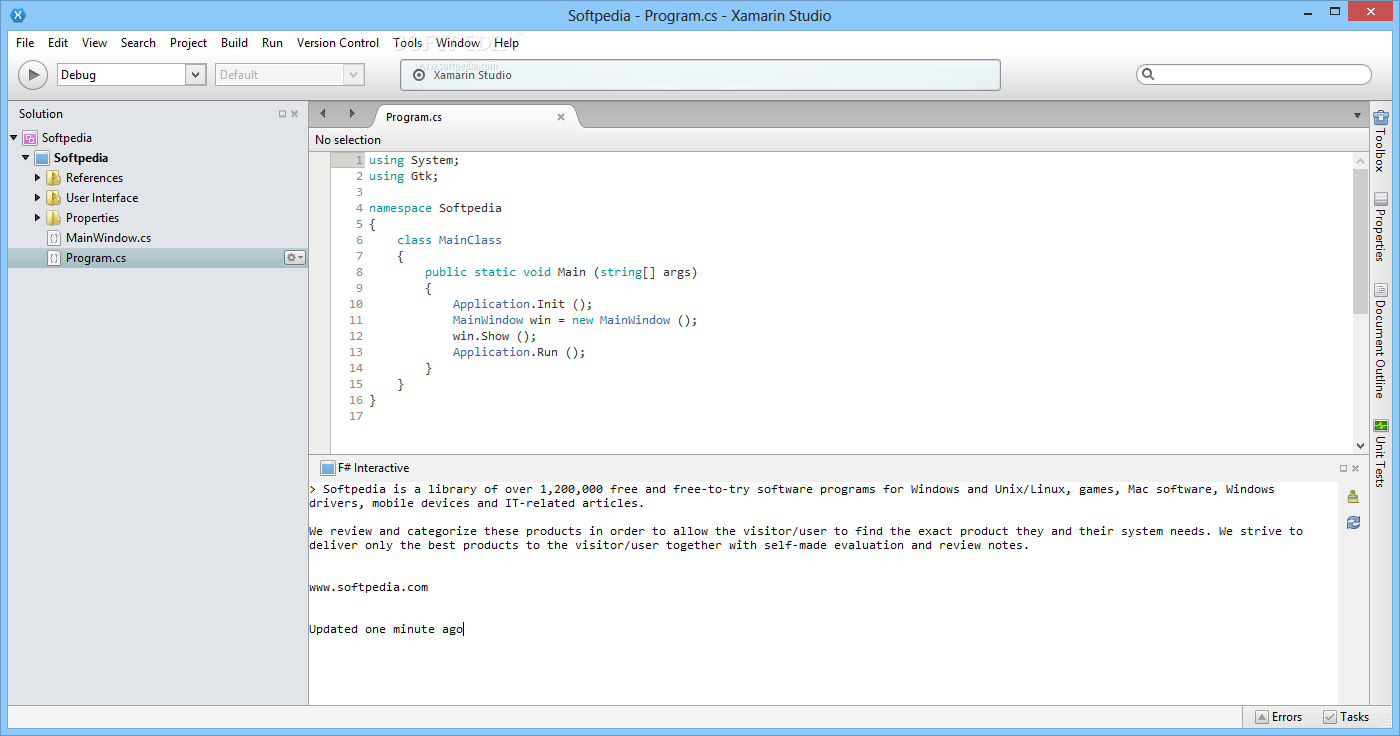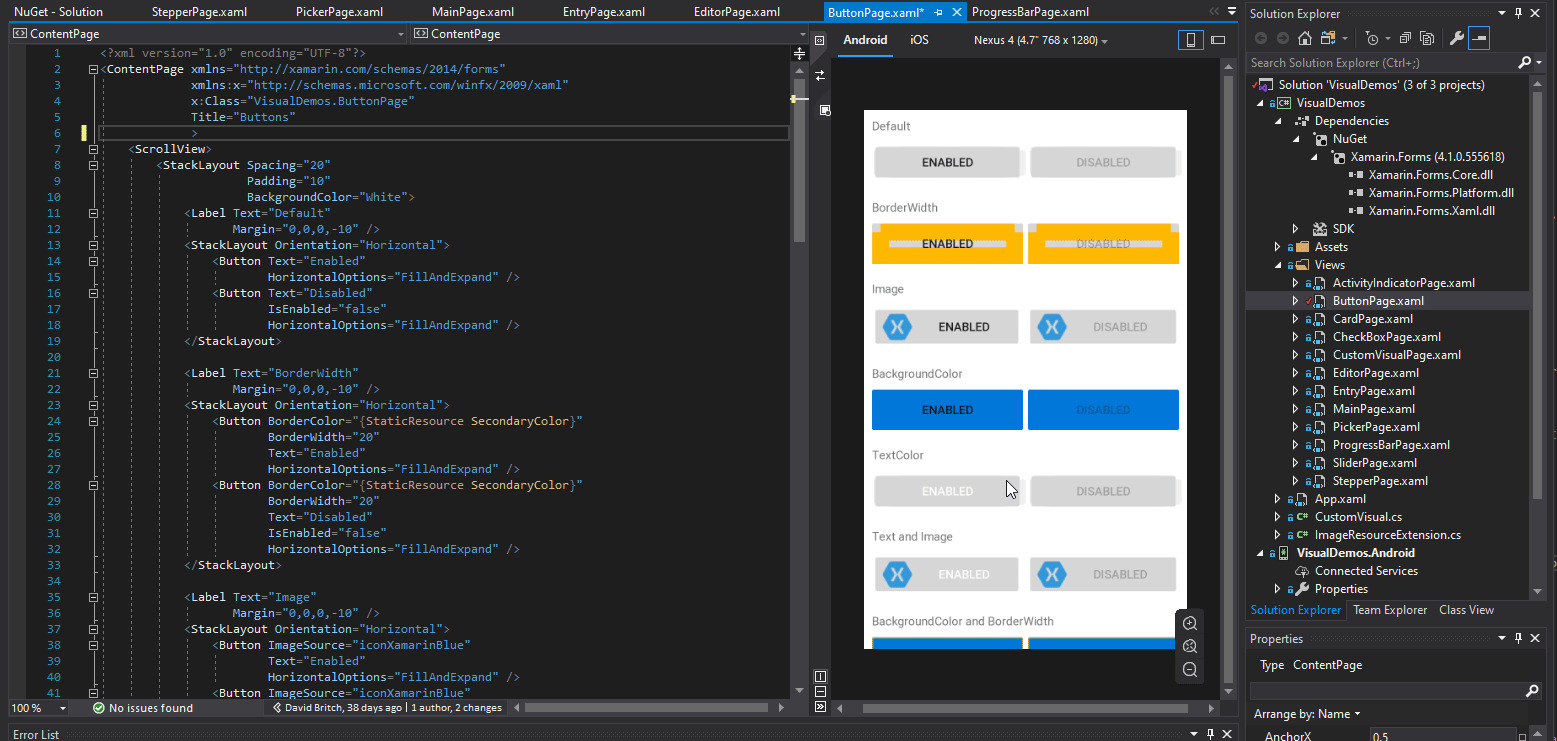- Prior to this Xamarin.Forms was found, afterwards it was no longer found by Visual Studio for an unknown reason. Restarting Visual Studio resolved the problem for me. This is likely only relevant if Xamarin.Forms was found before and suddenly went missing, a restart is obviously unsuitable in fixing errors with the project setup.
- ComponentOne Studio for Xamarin is a collection of native, cross-platform mobile controls with the same API across all platforms. With ComponentOne Studio for Xamarin you get calendars, data management controls for displaying, editing and manipulating data, as well as, data visualization controls for generating Cartesian charts, pie charts, gauges and bullet graphs.
Xamarin Studio is a Developer Tools application like HTMLPad, PSPad, and VB Extension from Xamarin Inc. It has a simple and basic user interface, and most importantly, it is free to download. Xamarin Studio is an efficient software that is recommended by many Windows PC users.
The Remoted iOS Simulator for Windows allows you to test your apps on aniOS simulator displayed in Windows alongside Visual Studio 2019 and Visual Studio 2017.
Getting started
Step-by-step instructions for installing.NET and building your first Hello World mobile application for iOS and Android. Develop with free tools for macOSand Windows. Installing Xamarin in Visual Studio 2019 allows you to start writing code for your apps, but does require additional setup for building and deploying your apps to simulator, emulator, and device. Visit the following guides to complete your installation and start building cross platform apps.
The Remoted iOS Simulator for Windows is installed automatically as partof Xamarin in Visual Studio 2019 and Visual Studio 2017. To use it, follow these steps:
- Pair Visual Studio 2019 to a Mac Build host.
- In Visual Studio, start debugging an iOS or tvOS project. TheRemoted iOS Simulator for Windows will appear on your Windows machine.
Watch this video for a step-by-step guide.
Simulator window
The toolbar at the top of the simulator's window contains a number of useful buttons:
Home – Simulates the home button on an iOS device.
Lock – Locks the simulator (swipe to unlock).
Screenshot – Saves a screenshot of the simulator (stored in PicturesXamariniOS Simulator).
Settings – Displays keyboard, location, and other settings.
Other options – Brings up various simulator options such as rotation, shake gestures, and Touch ID.
Settings

Clicking the toolbar's gear icon opens the Settings window:
These settings allow you to enable the hardware keyboard, choose alocation that the device should report (static and moving locations areboth supported), enable Touch ID, and reset the content and settings forthe simulator.
Other options
The toolbar's ellipsis button reveals other options such as rotation,shake gestures, and rebooting. These same options can be viewed as a listby right-clicking anywhere in the simulator's window:
Touchscreen support
Most modern Windows computers have touch screens. Since the Remoted iOSSimulator for Windows supports touch interactions, you can test your appwith the same pinch, swipe, and multi-finger touch gestures that you usewith physical iOS devices.
Similarly, the Remoted iOS Simulator for Windows treats Windows Stylusinput as Apple Pencil input.
Sound handling
Xamarin Studio Tutorial
Sounds played by the simulator will come from the host Mac's speakers.iOS sounds are not heard on the Windows computer.
Disabling the Remoted iOS Simulator for Windows
To disable the Remoted iOS Simulator for Windows, navigate toTools > Options > Xamarin > iOS Settings and uncheckRemote Simulator to Windows.
With this option disabled, debugging opens the iOS Simulator on the connected Mac build host.
Troubleshooting
If you experience issues with the Remoted iOS Simulator, you can view the logs in these locations: Bitdefender mac free download.

Xamarin Studio Tutorial
- Mac –
~/Library/Logs/Xamarin/Simulator.Server - Windows –
%LOCALAPPDATA%XamarinLogsXamarin.Simulator
If you report a problem in Visual Studio, attaching these logs might be helpful (there are options to keep uploads private).
If you don't have a device to deploy to, you'll need to set up an Android emulator or use a device. If you've already done this, you can skip this step.
If this if your first time building a Xamarin application, you'll need to create a new Android Emulator. You'll see 'Android Emulator' in the debug menu. Click it to start the creation process.
This brings up a UAC prompt to be accepted and then the emulator creation process. The options are automatically populated for a base emulator. If required, change any options and then select Create.

At this point, you may be prompted to agree to the license agreement for the Android emulator. Read through and select Accept to continue the process. This will download the emulator images and finalize the creation of the emulator for use in Visual Studio.
Once the emulator has been created, you'll see a button that says Start. Click it.
You may receive prompt to enable Windows Hypervisor Platform. Follow the documentation to enable this feature for optimal performance.
The Android emulator will launch. Wait for it to fully finish starting and you'll see it displayed in the Visual Studio debug menu. This may take some time if you aren't using hardware acceleration.
Xamarin Studio Ide
Your Android emulator has now been created and is ready to use. Next time you run Visual Studio, the emulator will appear directly in the debug target window and will start when you select it. If you ran into any issues or have performance issues with the emulator, read through the full setup documentation.
Xamarin Studio Ide
For this tutorial, we'll focus on setting up and deploying to Android. To deploy to the application to iOS, you'll need to configure the Remoted iOS Simulator for Windows or configure a device for deployment with Hot Restart.
